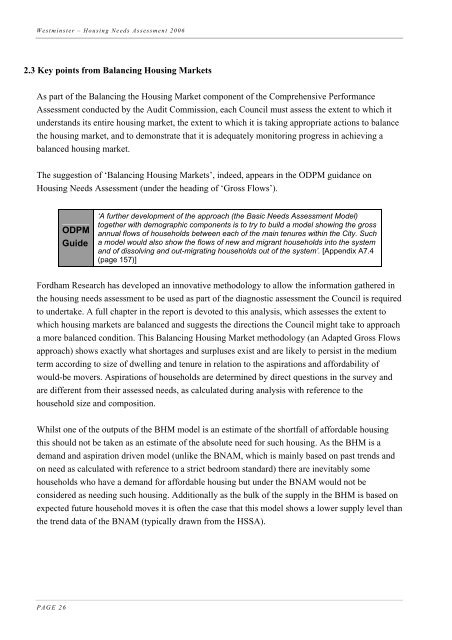Housing Needs Assessment 2006 - Westminster City Council
Housing Needs Assessment 2006 - Westminster City Council
Housing Needs Assessment 2006 - Westminster City Council
- No tags were found...
You also want an ePaper? Increase the reach of your titles
YUMPU automatically turns print PDFs into web optimized ePapers that Google loves.
<strong>Westminster</strong> – <strong>Housing</strong> <strong>Needs</strong> <strong>Assessment</strong> <strong>2006</strong>2.3 Key points from Balancing <strong>Housing</strong> MarketsAs part of the Balancing the <strong>Housing</strong> Market component of the Comprehensive Performance<strong>Assessment</strong> conducted by the Audit Commission, each <strong>Council</strong> must assess the extent to which itunderstands its entire housing market, the extent to which it is taking appropriate actions to balancethe housing market, and to demonstrate that it is adequately monitoring progress in achieving abalanced housing market.The suggestion of ‘Balancing <strong>Housing</strong> Markets’, indeed, appears in the ODPM guidance on<strong>Housing</strong> <strong>Needs</strong> <strong>Assessment</strong> (under the heading of ‘Gross Flows’).ODPMGuide‘A further development of the approach (the Basic <strong>Needs</strong> <strong>Assessment</strong> Model)together with demographic components is to try to build a model showing the grossannual flows of households between each of the main tenures within the <strong>City</strong>. Sucha model would also show the flows of new and migrant households into the systemand of dissolving and out-migrating households out of the system’. [Appendix A7.4(page 157)]Fordham Research has developed an innovative methodology to allow the information gathered inthe housing needs assessment to be used as part of the diagnostic assessment the <strong>Council</strong> is requiredto undertake. A full chapter in the report is devoted to this analysis, which assesses the extent towhich housing markets are balanced and suggests the directions the <strong>Council</strong> might take to approacha more balanced condition. This Balancing <strong>Housing</strong> Market methodology (an Adapted Gross Flowsapproach) shows exactly what shortages and surpluses exist and are likely to persist in the mediumterm according to size of dwelling and tenure in relation to the aspirations and affordability ofwould-be movers. Aspirations of households are determined by direct questions in the survey andare different from their assessed needs, as calculated during analysis with reference to thehousehold size and composition.Whilst one of the outputs of the BHM model is an estimate of the shortfall of affordable housingthis should not be taken as an estimate of the absolute need for such housing. As the BHM is ademand and aspiration driven model (unlike the BNAM, which is mainly based on past trends andon need as calculated with reference to a strict bedroom standard) there are inevitably somehouseholds who have a demand for affordable housing but under the BNAM would not beconsidered as needing such housing. Additionally as the bulk of the supply in the BHM is based onexpected future household moves it is often the case that this model shows a lower supply level thanthe trend data of the BNAM (typically drawn from the HSSA).PAGE 26
















